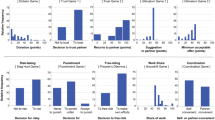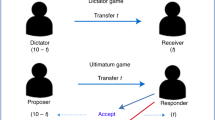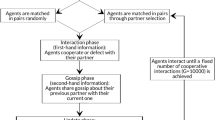Abstract
Acts of prosociality, such as donating to charity, are often analysed in a similar way to acts of conspicuous advertising; both involve costly signals revealing hidden qualities that increase the signaller’s prestige. However, experimental work suggests that grand gestures, even if prosocial, may damage one’s reputation for trustworthiness and cooperativeness if they are perceived as prestige enhancing: individuals may gain some types of cooperative benefits only when they perform prosocial acts in particular ways. Here, we contrast subtle, less obviously costly, interpersonal forms of prosocial behaviour with high-cost displays to a large audience, drawing on the example of food sharing in subsistence economies. This contrast highlights how highly visible prosocial displays may be effective for attracting new partners, while subtle signals may be crucial for ensuring trust and commitment with long-term partners. Subtle dyadic signals may be key to understanding the long-term maintenance of interpersonal networks that function to reduce unanticipated risks.
This is a preview of subscription content, access via your institution
Access options
Access Nature and 54 other Nature Portfolio journals
Get Nature+, our best-value online-access subscription
$29.99 / 30 days
cancel any time
Subscribe to this journal
Receive 12 digital issues and online access to articles
$119.00 per year
only $9.92 per issue
Buy this article
- Purchase on Springer Link
- Instant access to full article PDF
Prices may be subject to local taxes which are calculated during checkout
Similar content being viewed by others
References
Noë, R. & Hammerstein, P. Biological markets: supply and demand determine the effect of partner choice in cooperation, mutualism and mating. Behav. Ecol. Sociobiol. 35, 1–11 (1994).
Sylwester, K. & Roberts, G. Cooperators benefit through reputation-based partner choice in economic games. Biol. Lett. 6, 659–662 (2010).
Sylwester, K. & Roberts, G. Reputation-based partner choice is an effective alternative to indirect reciprocity in solving social dilemmas. Evol. Hum. Behav. 34, 201–206 (2013).
Barclay, P. Competitive helping increases with the size of biological markets and invades defection. J. Theor. Biol. 281, 47–55 (2011).
Debove, S., André, J. B. & Baumard, N. Partner choice creates fairness in humans. Proc. R. Soc. B Biol. Sci. 282, 20150392 (2015).
Debove, S., Baumard, N. & André, J. B. On the evolutionary origins of equity. PLoS ONE 12, e0173636 (2017).
Hammerstein, P. & Noë, R. Biological trade and markets. Phil. Trans. R. Soc. B 371, 20150101 (2016).
Gambetta, D. Trust: Making and Breaking Cooperative Relations (B. Blackwell, Oxford, 1988).
Nesse, R. M. (ed.) Evolution and the Capacity for Commitment (Russell Sage, New York, NY, 2001).
Frank, R. H. Passions Within Reason: The Strategic Role of the Emotions (Norton, New York, NY, 1988).
Fuhrmann, M. & Sechser, T. S. Signaling alliance commitments: hand-tying and sunk costs in extended nuclear deterrence. Am. J. Polit. Sci. 58, 919–935 (2014).
Yamaguchi, M., Smith, A. & Ohtsubo, Y. Commitment signals in friendship and romantic relationships. Evol. Hum. Behav. 36, 467–474 (2015).
Barclay, P. Strategies for cooperation in biological markets, especially for humans. Evol. Hum. Behav. 34, 164–175 (2013).
Raihani, N. J. & Barclay, P. Exploring the trade-off between quality and fairness in human partner choice. R. Soc. Open Sci. 3, 160510 (2016).
Bracha, A. & Vesterlund, L. Mixed signals: charity reporting when donations signal generosity and income. Games Econ. Behav. 104, 24–42 (2017).
Gurven, M., Allen-Arave, W., Hill, K. & Hurtado, M. It’s a wonderful life’: signaling generosity among the Ache of Paraguay. Evol. Hum. Behav. 21, 263–282 (2000).
Bliege Bird, R., Scelza, B., Bird, D. W. & Smith, E. A. The hierarchy of virtue: mutualism, altruism and signaling in Martu women’s cooperative hunting. Evol. Hum. Behav. 33, 64–78 (2012).
Bliege Bird, R. & Power, E. A. Prosocial signaling and cooperation among Martu hunters. Evol. Hum. Behav. 36, 389–397 (2015).
Bourdieu, P. in Handbook of Theory and Research for the Sociology of Education (ed. Richardson,J.) 241–258 (Greenwood Press, New York, NY, 1986).
Lin, N. Social Capital: A Theory of Social Structure and Action (Cambridge Univ. Press, New York, NY, 2001).
Holt-Lunstad, J., Smith, T. B. & Layton, J. B. Social relationships and mortality risk: a meta-analytic review. PLoS Med. 7, e1000316 (2010).
Hruschka, D. J. Friendship: Development, Ecology, and Evolution of a Relationship (Univ. California Press, Berkeley, CA, 2010).
Lyle, H. F. & Smith, E. A. The reputational and social network benefits of prosociality in an Andean community. Proc. Natl Acad. Sci. USA 111, 4820–4825 (2014).
Kim, D. A., Benjamin, E. J., Fowler, J. H. & Christakis, N. A. Social connectedness is associated with fibrinogen level in a human social network. Proc. R. Soc. B Biol. Sci. 283, 20160958 (2016).
Dunbar, R. I. M. Breaking bread: the functions of social eating. Adapt. Hum. Behav. Physiol. 3, 1–14 (2017).
Page, A. E. et al. Hunter-gatherer social networks and reproductive success. Sci. Rep. 7, 1153 (2017).
Silk, J. B. et al. The benefits of social capital: close social bonds among female baboons enhance offspring survival. Proc. R. Soc. B Biol. Sci. 276, 3099–3104 (2009).
Jaeggi, A. V. & Van Schaik, C. P. The evolution of food sharing in primates. Behav. Ecol. Sociobiol. 65, 2125–2140 (2011).
Jaeggi, A. V. & Gurven, M. Natural cooperators: food sharing in humans and other primates. Evol. Anthropol. Issues News Rev. 22, 186–195 (2013).
McFarland, R. et al. The ‘strength of weak ties’ among female baboons: fitness-related benefits of social bonds. Anim. Behav. 126, 101–106 (2017).
Akerlof, G. A. The market for’ lemons’: quality uncertainty and the market mechanism. Q. J. Econ. 84, 488–500 (1970).
Grafen, A. Biological signals as handicaps. J. Theor. Biol. 144, 517–546 (1990).
Grafen, A. Sexual selection unhandicapped by the Fisher process. J. Theor. Biol. 144, 473–516 (1990).
Zahavi, A. Mate selection — a selection for a handicap. J. Theor. Biol. 53, 205–214 (1975).
Gintis, H., Smith, E. A. & Bowles, S. Costly signaling and cooperation. J. Theor. Biol. 213, 103–119 (2001).
Smith, E. A. & Bliege Bird, R. in Moral Sentiments and Material Interests: The Foundations of Cooperation inEconomic Life (eds Gintis, H., Bowles, S., Boyd, R. & Fehr, E.) 115–148 (MIT Press, Cambridge, MA, 2006).
Barclay, P. & Willer, R. Partner choice creates competitive altruism in humans. Proc. R. Soc. B Biol. Sci. 274, 749–753 (2007).
Berman, J. Z., Levine, E. E., Barasch, A. & Small, D. A. The braggart’s dilemma: on the social rewards and penalties of advertising prosocial behavior. J. Mark. Res. 52, 90–104 (2014).
Hoffman, M., Yoeli, E. & Nowak, M. A. Cooperate without looking: why we care what people think and not just what they do. Proc. Natl Acad. Sci. USA 112, 1727–1732 (2015).
Jordan, J. J., Hoffman, M., Nowak, M. A. & Rand, D. G. Uncalculating cooperation is used to signal trustworthiness. Proc. Natl Acad. Sci. USA 113, 8658–8663 (2016).
Przepiorka, W. & Liebe, U. Generosity is a sign of trustworthiness—the punishment of selfishness is not. Evol. Hum. Behav. 37, 255–262 (2016).
Gambetta, D. & Przepiorka, W. Natural and strategic generosity as signals of trustworthiness. PloS ONE 9, e97533 (2014).
Silk, J. B. in Evolution and the Capacity for Commitment (ed. Nesse, R. M.) 138–157 (Russell Sage, New York, NY, 2001).
Silk, J. B. in Genetic and Cultural Evolution of Cooperation (ed. Hammerstein, P.) 37–54 (MIT Press,Cambridge, MA, 2003).
Hurd, P. L. & Enquist, M. A strategic taxonomy of biological communication. Anim. Behav. 70, 1155–1170 (2005).
Searcy, W. A. & Nowicki, S. The Evolution of Animal Communication: Reliability and Deception in Signaling Systems (Princeton Univ. Press, Princeton, NJ, 2005).
Számadó, S. The cost of honesty and the fallacy of the handicap principle. Anim. Behav. 81, 3–10 (2011).
Zollman, K. J. S. Finding alternatives to handicap theory. Biol. Theory 8, 127–132 (2013).
Silk, J. B., Kaldor, E. & Boyd, R. Cheap talk when interests conflict. Anim. Behav. 59, 423–432 (2000).
Macfarlan, S. J. & Lyle, H. F. Multiple reputation domains and cooperative behaviour in two Latin American communities. Phil. Trans. R. Soc. B 370, 20150009 (2015).
Macfarlan, S. J., Quinlan, R. & Remiker, M. Cooperative behaviour and prosocial reputation dynamics in a Dominican village. Proc. R. Soc. Lond. B Biol. Sci. 280, 20130557 (2013).
Bliege Bird, R., Smith, E. A. & Bird, D. W. The hunting handicap: costly signaling in human foraging strategies. Behav. Ecol. Sociobiol. 50, 9–19 (2001).
Smith, E. A., Bliege Bird, R. & Bird, D. W. The benefits of costly signaling: Meriam turtle hunters. Behav. Ecol. 14, 116–126 (2003).
Nolin, D. A. Food-sharing networks in Lamalera, Indonesia: status, sharing, and signaling. Evol. Hum. Behav. 33, 334–345 (2012).
Hawkes, K., O’Connell, J. F. & Blurton Jones, N. G. Hadza meat sharing. Evol. Hum. Behav. 22, 113–142 (2001).
Gurven, M., Hill, K., Kaplan, H., Hurtado, A. & Lyles, R. Food transfers among Hiwi foragers of Venezuela: tests of reciprocity. Hum. Ecol. 28, 171–218 (2000).
Endicott, K. in Hunters and Gatherers Vol. 2: Property, Power and Ideology (eds Ingold, D., Riches, T. & Woodburn, J.) 110–127 (Berg, Oxford, 1988).
Blurton Jones, N. G. Demography and Evolutionary Ecology of Hadza Hunter-Gatherers 71 (Cambridge Univ. Press, Cambridge, 2016).
Bliege Bird, R., Bird, D. W., Smith, E. A. & Kushnick, G. C. Risk and reciprocity in Meriam food sharing. Evol. Hum. Behav. 23, 297–321 (2002).
Bliege Bird, R. & Bird, D. W. Why women hunt. Curr. Anthropol. 49, 655–693 (2008).
Gurven, M. To give and to give not: the behavioral ecology of human food transfers. Behav. Brain Sci. 27, 543–559 (2004).
Jaeggi, A.V. & Gurven, M. Reciprocity explains food sharing in humans and other primates independent of kin selection and tolerated scrounging: a phylogenetic meta-analysis. Proc. R. Soc. B Biol. Sci. 280, 20131615 (2013).
Bodenhorn, B. in The Social Economy of Sharing: Resource Allocation and ModernHunter Gatherers (eds Wenzel, G., Hovelsrud-Broda, G. & Kishigami, N.) 27–60 (Senri Ethnological Studies, Osaka, 2000).
Bird, D. W., Bliege Bird, R., Codding, B. F. & Taylor, N. A landscape architecture of fire: cultural emergence and ecological pyrodiversity in Australia’s Western Desert. Curr. Anthropol. 57, S65–S79 (2016).
Gurven, M., Hill, K. & Jakugi, F. Why do foragers share and sharers forage? Explanations of the social dimensions of foraging. Res. Econ. Anthropol. 23, 19–43 (2004).
Macfarlan, S. J., Remiker, M. & Quinlan, R. Competitive altruism explains labor exchange variation in a Dominican community. Curr. Anthropol. 53, 118–124 (2012).
Stegmann, U. E. Animal Communication Theory: Information and Influence (Cambridge Univ. Press, Cambridge, 2013).
Rand, D. G., Arbesman, S. & Christakis, N. A. Dynamic social networks promote cooperation in experiments with humans. Proc. Natl Acad. Sci. USA 108, 19193–19198 (2011).
Nishi, A., Shirado, H., Rand, D. G. & Christakis, N. A. Inequality and visibility of wealth in experimental social networks. Nature 526, 426–429 (2015).
Wang, J., Suri, S. & Watts, D. J. Cooperation and assortativity with dynamic partner updating. Proc. Natl Acad. Sci. USA 109, 14363–14368 (2012).
Ohtsuki, H., Iwasa, Y. & Nowak, M. A. Reputation effects in public and private interactions. PLoS Comput. Biol. 11, e1004527 (2015).
Melamed, D. & Simpson, B. Strong ties promote the evolution of cooperation in dynamic networks. Soc. Netw. 45, 32–44 (2016).
Sutcliffe, A. G., Dunbar, R. I. M. & Wang, D. Modelling the evolution of social structure. PLoS ONE 11, e0158605 (2016).
Power, E. A. Social support networks and religiosity in rural South India. Nat. Hum. Behav. 1, 0057 (2017).
Bowser, B. J. & Patton, J. Q. in The Evolution of Leadership: Transitions in Decision Making from Small-Scale to Middle-Range Societies (eds Vaughn, K. J., Eerkens, J. W. & Kantner, J.) 51–71 (School for Advanced Research Press, Santa Fe, NM, 2010).
Kivelä, M. et al. Multilayer networks. J. Complex Netw. 2, 203–271 (2014).
Jackson, M. O., Rodriguez-Barraquer, T. & Tan, X. Social capital and social quilts: network patterns of favor exchange. Am. Econ. Rev. 102, 1857–1897 (2012).
Nolin, D. A. Food-sharing networks in Lamalera, Indonesia: reciprocity, kinship, and distance. Hum. Nat. 21, 243–268 (2010).
Nolin, D. Kin preference and partner choice. Hum. Nat. 22, 156–176 (2011).
Apicella, C. L., Marlowe, F. W., Fowler, J. H. & Christakis, N. A. Social networks and cooperation in hunter-gatherers. Nature 481, 497–501 (2012).
Hooper, P. L., DeDeo, S., Caldwell Hooper, A. E., Gurven, M. & Kaplan, H. S. Dynamical structure of a traditional Amazonian social network. Entropy 15, 4932–4955 (2013).
Kasper, C. & Borgerhoff Mulder, M. Who helps and why?: Cooperative networks in Mpimbwe. Curr. Anthropol. 56, 701–732 (2015).
Dyble, M. et al. Networks of food sharing reveal the functional significance of multilevel sociality in two hunter-gatherer groups. Curr. Biol. 26, 2017–2021 (2016).
Koster, J. M. & Leckie, G. Food sharing networks in lowland Nicaragua: an application of the social relations model to count data. Soc. Netw. 38, 100–110 (2014).
Ziker, J. P., Rasmussen, J. & Nolin, D. A. Indigenous Siberians solve collective action problems through sharing and traditional knowledge. Sustain. Sci. 11, 45–55 (2016).
Ready, E. & Power, E.A. Why wage earners hunt: food sharing, social structure, and influence in an Arctic mixed economy. Curr. Anthropol 59, 74–97 (2018).
Mauss, M. The Gift: Forms and Functions of Exchange in Archaic Societies (Free Press, Glencoe, IL, 1954).
Author information
Authors and Affiliations
Contributions
All authors contributed equally to the writing of the paper.
Corresponding author
Ethics declarations
Acknowledgements
The research results reported in Box 1 were supported by National Science Foundation BCS 1459880.
Competing interests
The authors declare no competing interests.
Additional information
Publisher’s note: Springer Nature remains neutral with regard to jurisdictional claims in published maps and institutional affiliations.
Rights and permissions
About this article
Cite this article
Bliege Bird, R., Ready, E. & Power, E.A. The social significance of subtle signals. Nat Hum Behav 2, 452–457 (2018). https://doi.org/10.1038/s41562-018-0298-3
Received:
Accepted:
Published:
Issue Date:
DOI: https://doi.org/10.1038/s41562-018-0298-3
This article is cited by
-
Predictors and motives for mask-wearing behavior and vaccination intention
Scientific Reports (2023)
-
Social Support and Network Formation in a Small-Scale Horticulturalist Population
Scientific Data (2022)
-
Deconstructing Hunting Returns: Can We Reconstruct and Predict Payoffs from Pursuing Prey?
Journal of Archaeological Method and Theory (2022)
-
Explaining costly religious practices: credibility enhancing displays and signaling theories
Synthese (2022)
-
Four Puzzles of Reputation-Based Cooperation
Human Nature (2022)



